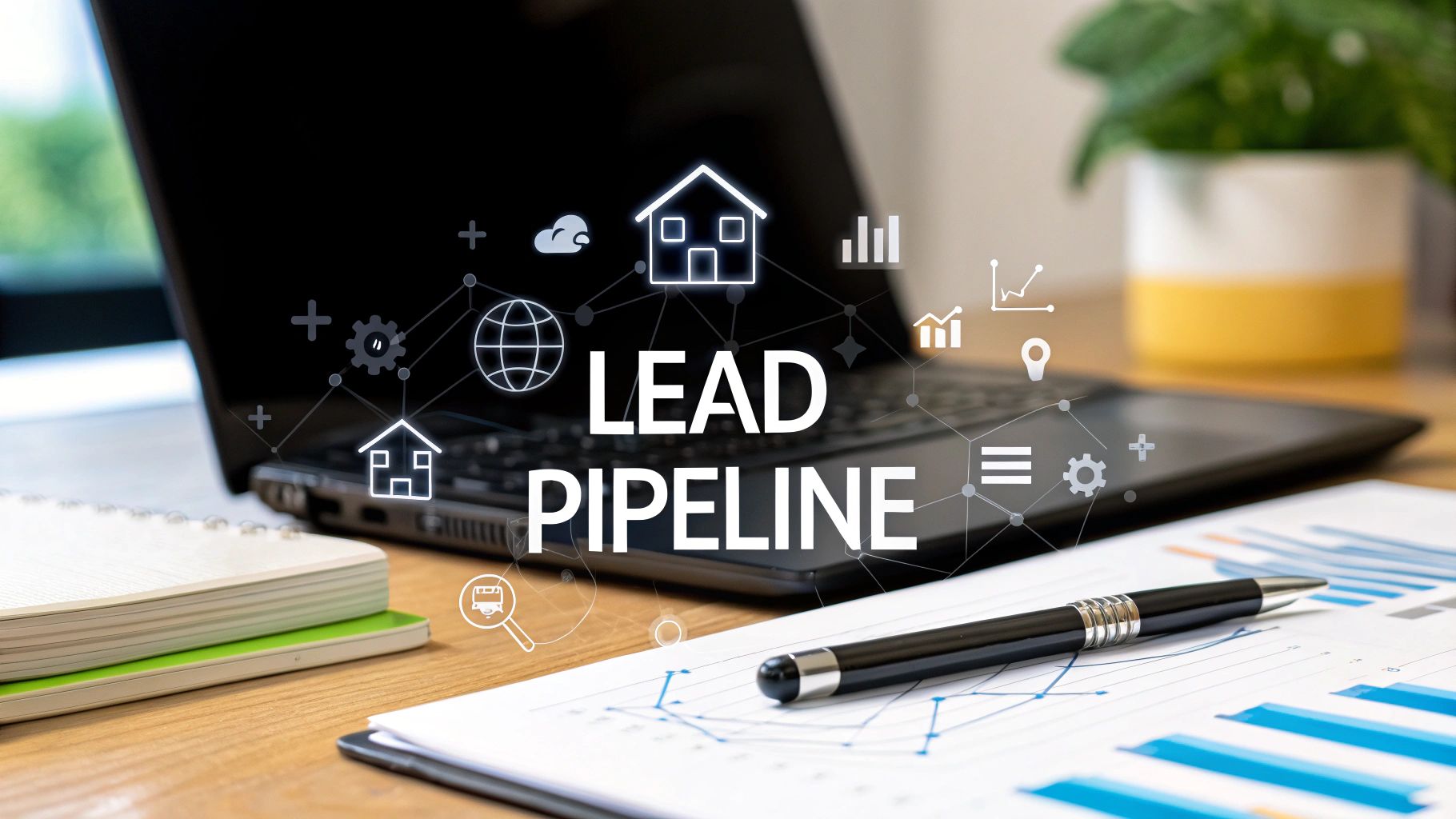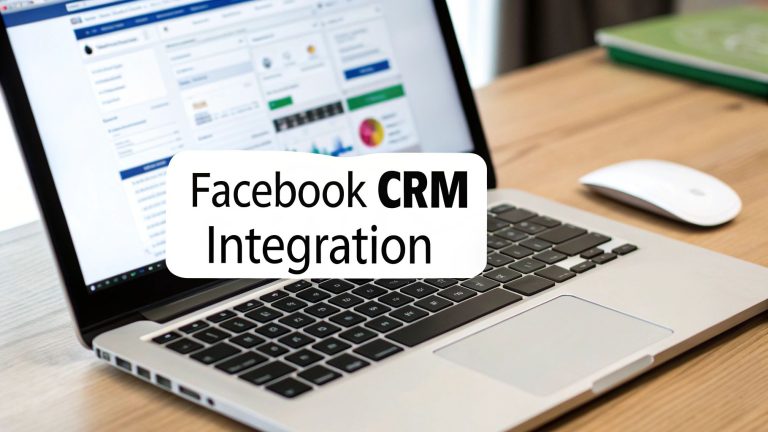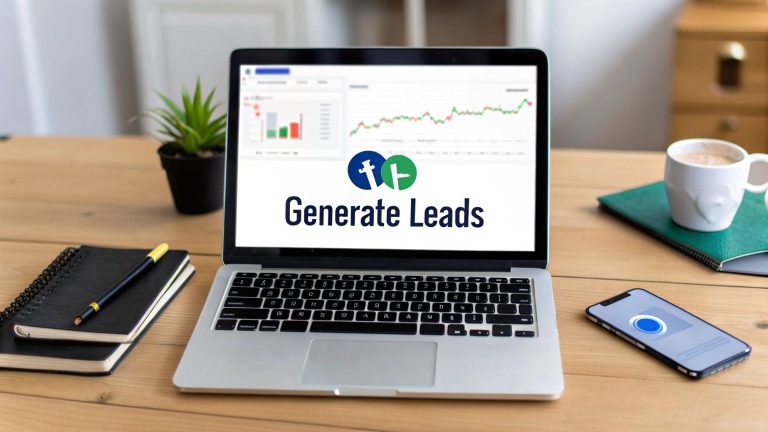Real Estate Lead Generation Software: Grow Your Pipeline
Real estate lead generation software is a specialized tool that automates the whole process of finding, nurturing, and managing potential clients for your real estate business.
Think of it as a digital assistant working 24/7. It's there to make sure no opportunity ever falls through the cracks, turning scattered interest into a predictable pipeline of warm leads.
What Is Real Estate Lead Generation Software Anyway?
Imagine you're fishing. You could stand by the water all day, casting a single line and just hoping for a bite. Or, you could set up a sophisticated network of lines, each with the perfect bait, that alerts you the moment a fish is interested.
Real estate lead generation software is that advanced network for your business.
It’s way more than just a digital address book or a simple CRM. It’s an active engine built to attract potential buyers and sellers, engage them automatically, and hand them over to you when they're actually ready to talk. The system pulls all your lead capture efforts—from your website, social media ads, and online portals—into one organized command center.
The Core Function of Lead Software
At its heart, this software solves the two biggest headaches for any agent: time and consistency. Manually tracking every email, text, and website inquiry is next to impossible as your business grows. This technology automates all those repetitive follow-up tasks, ensuring every single lead gets a timely response. In a competitive market, that speed is everything.
A well-implemented lead generation system doesn't just collect contacts; it builds relationships at scale. It lets you focus your energy on high-value activities like negotiations and closings, not cold calling and data entry.
This infographic breaks down the fundamental workflow of attracting, nurturing, and delivering leads.

As you can see, it's a clear progression from casting a wide net to a focused, actionable outcome—which is exactly what any good lead generation tool should deliver.
A Growing Market for a Critical Need
The demand for these platforms is surging as more agents move their marketing online. As of 2025, the global market for this software is valued anywhere from $361.2 million to $1.2 billion, with strong growth expected to continue. This boom is all about the need for smarter, more efficient marketing and sales in the real estate world.
To get the big picture, it helps to explore the general real estate lead generation strategies that agents use every day. These tactics are the foundation that software helps automate and amplify. You can also dive deeper into the fundamentals by reading our complete guide on what is lead generation in marketing.
Core Features That Actually Drive Growth
A powerful engine isn't just one big piece of metal; it’s a collection of precision-engineered parts working in perfect harmony. The same goes for the best real estate lead generation software. It's not a single trick pony but a suite of integrated features designed to power your entire client acquisition pipeline.
Let's pop the hood and look at the core functions that turn scattered interest into closed deals.
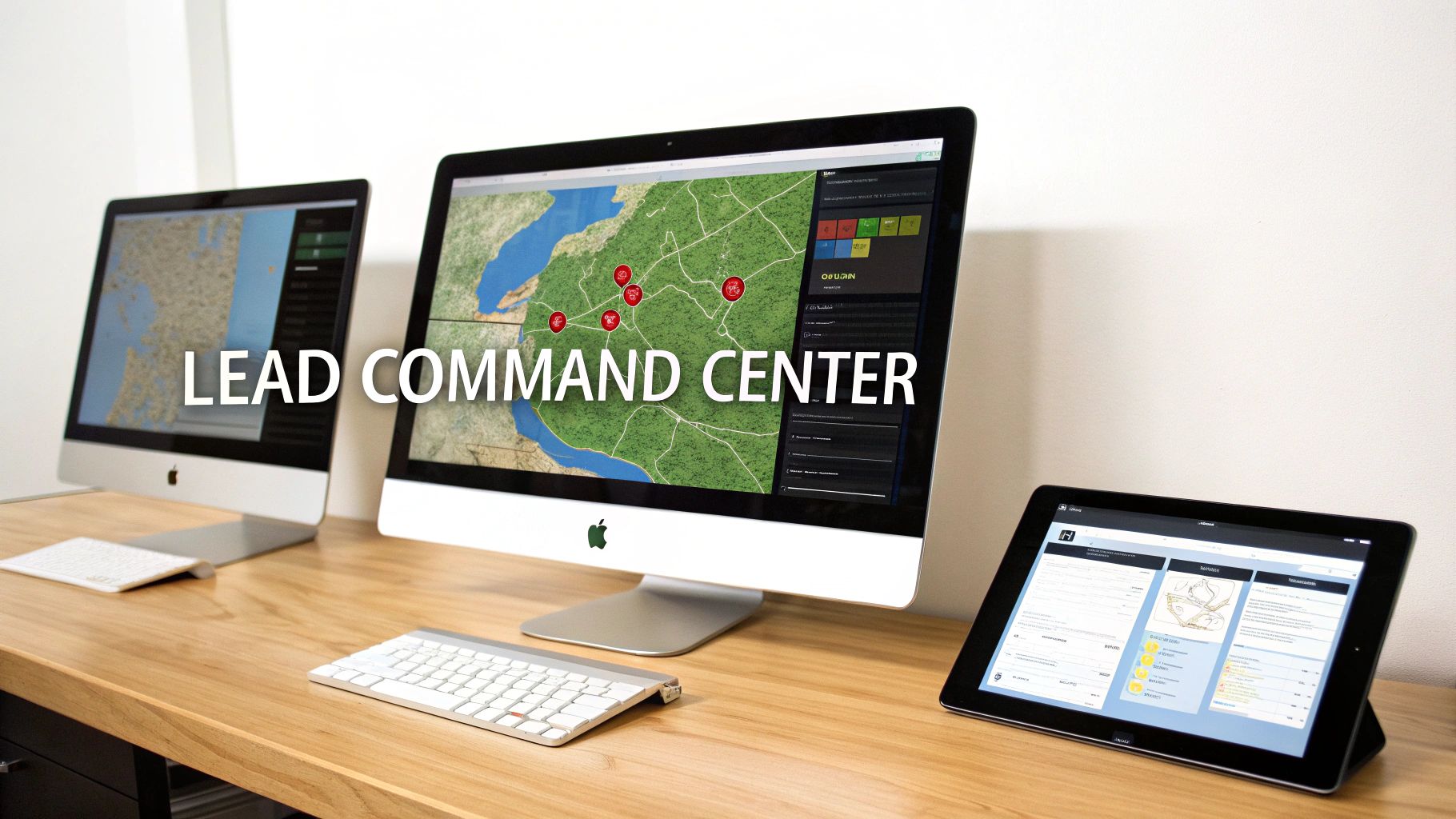
These features aren't just flashy add-ons. They are practical solutions to the daily headaches agents face, from drowning in contacts to letting hot leads slip through the cracks.
Seamless CRM Integration
Think of your Customer Relationship Management (CRM) system as your digital brain. It’s where every client detail, conversation history, and important date lives. When your lead gen software plugs right into your CRM, it creates a single, undeniable source of truth for your entire business.
This connection kills manual data entry—a task that’s not only a massive time-suck but also an open invitation for errors. Every new lead grabbed from your website or a social media ad automatically populates in your CRM, tagged with where they came from and what they asked about. This gives you a complete picture of each client's journey, all in one spot. You can dive deeper into how this works in our guide on lead tracking software.
Multi-Channel Lead Capture
In today's market, leads can pop up from anywhere: your website's contact form, a Facebook ad, a Zillow inquiry, or an open house sign-in sheet. Juggling all those sources without a central system is pure chaos.
Good lead gen software acts like a universal funnel. It captures leads from all these different channels and pours them into one organized dashboard. This gives you a clear, unified view of your entire pipeline and shows you which marketing efforts are actually paying off.
Key capture points usually include:
- Website Forms: Instantly grab info from "Contact Us" or "Home Valuation" forms.
- Social Media Ads: Connect directly to platforms like Facebook Lead Ads to import contacts the second they sign up.
- Real Estate Portals: Integrate with major portals like Zillow and Realtor.com to automatically pull inquiries on your listings.
- Manual Entry: Quickly add the people you meet at open houses or networking events.
Automated Follow-Up Sequences
Speed is the name of the game. How fast you respond is often the single biggest factor in converting a new lead. Automated follow-up sequences guarantee that every single inquiry gets an immediate, personal-feeling response, even if it comes in at 2 AM.
These sequences, often called "drip campaigns," are pre-built series of emails and text messages that nurture a lead over time. For example, a new buyer lead might instantly get a welcome email, followed by a text a few hours later, then a series of helpful articles about the home-buying process over the next few weeks. This persistent, valuable communication keeps you top-of-mind without you having to lift a finger.
This tireless automation is your secret weapon. It engages prospects while you're in meetings, showing properties, or even sleeping, ensuring consistent follow-up that builds trust and rapport from the very first interaction.
Intelligent Lead Scoring and Prioritization
Let's be honest: not all leads are created equal. Some are ready to sign papers tomorrow, while others are just kicking tires. Intelligent lead scoring helps you tell the difference so you can focus your energy where it counts.
The software assigns points to leads based on what they do. A prospect who visits your pricing page three times, opens every email, and requests a showing will have a much higher score than someone who just downloaded a free neighborhood guide. This system helps you prioritize your call list, ensuring you talk to the hottest leads first. Modern platforms are getting seriously smart about this, with some using AI-powered dialers that can boost call efficiency by 73% by zeroing in on these high-priority contacts.
To help you see how these pieces fit together, here’s a quick breakdown of the essential features and the real-world value they bring to your business.
Essential Features of Lead Generation Software and Their Benefits
| Feature | What It Does | Primary Benefit for Agents |
|---|---|---|
| CRM Integration | Automatically syncs new leads and their data with your primary contact database. | Eliminates manual data entry, reduces errors, and creates a single source of truth for all client interactions. |
| Multi-Channel Capture | Collects leads from websites, social media, real estate portals, and manual inputs into one dashboard. | Provides a unified view of all lead sources, making it easy to track marketing ROI and manage contacts efficiently. |
| Automated Follow-Up | Sends pre-written sequences of emails and text messages to new leads automatically. | Ensures instant and consistent follow-up 24/7, increasing engagement and conversion rates without extra work. |
| Lead Scoring | Ranks leads based on their behavior (e.g., website visits, email opens) and demographic data. | Helps you prioritize outreach by identifying the "hottest" leads who are most likely to convert, saving time and effort. |
| Reporting & Analytics | Tracks key metrics like lead volume by source, conversion rates, and campaign performance. | Delivers data-driven insights to help you understand what's working and make smarter marketing decisions. |
Each of these features tackles a specific challenge in the lead generation process, turning what was once a manual, chaotic effort into a smooth, automated system that fuels business growth.
The Real-World Benefits of Automating Your Outreach
Features are just tools in a toolbox. What really matters is what you can build with them. When we talk about real estate lead generation software, the magic isn't in the technical specs—it's in the tangible, day-to-day results it brings to your business. It’s about turning chaos into clarity and missed chances into closed deals.
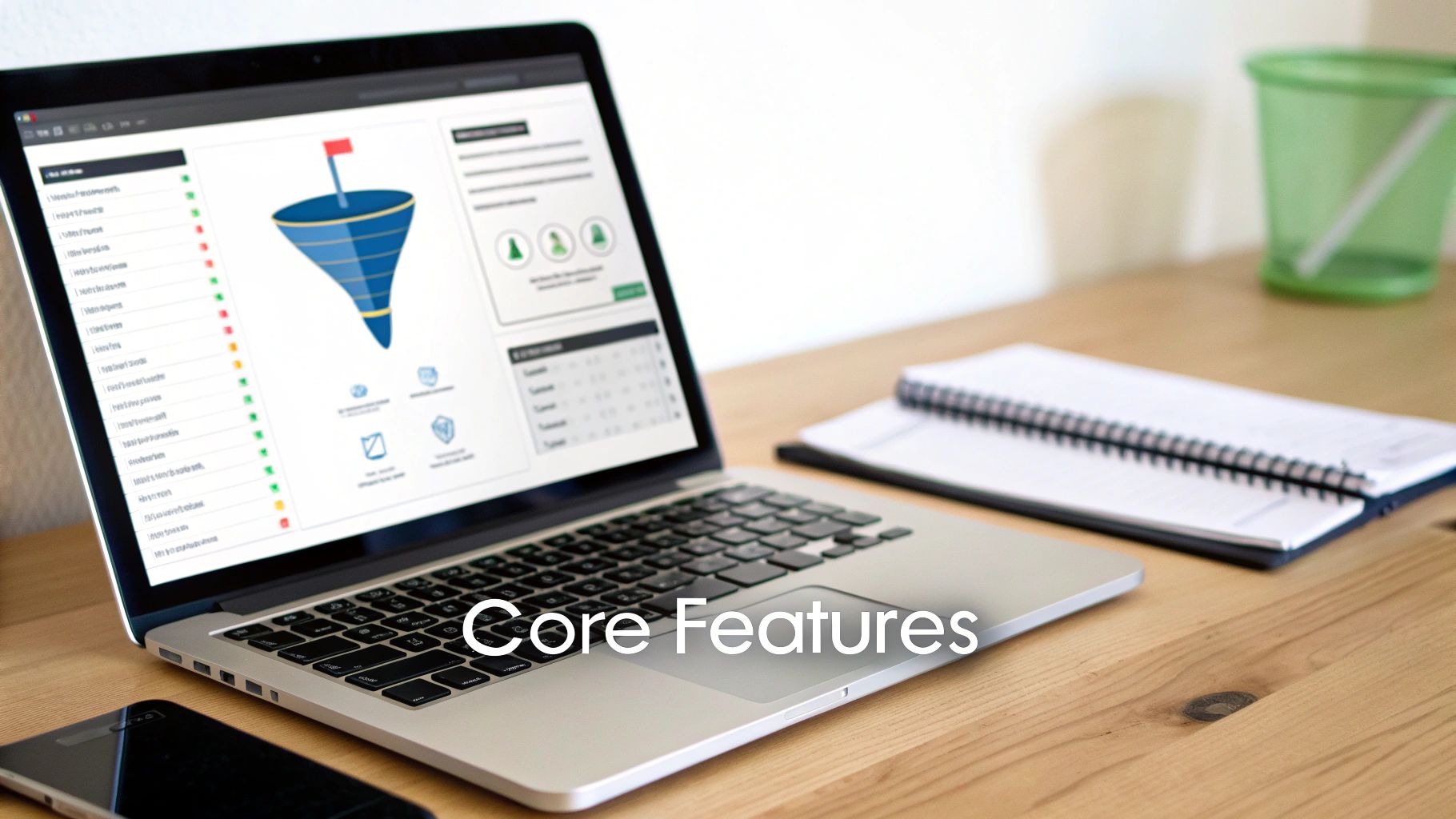
Think about an agent—let's call her Sarah—who is buried under a mountain of sticky notes and a sprawling spreadsheet. She wastes hours every week just trying to log inquiries, write follow-up emails, and remember who she needs to call next. Hot leads go cold simply because she’s busy showing a property and can't respond right away. It's a never-ending, exhausting cycle of just trying to keep up.
Now, let's look at Sarah after she gets an automated system. A new lead from Facebook comes in, and the software instantly sends a personalized welcome text and email. Over the next few weeks, it keeps nurturing that lead with helpful market info. Sarah is finally free to focus on negotiating offers and building real relationships, knowing her pipeline is being filled and managed 24/7. This isn't some far-off dream; it's what smart automation does.
Reclaim Your Most Valuable Asset: Your Time
The first thing agents notice is the incredible amount of time they get back. All those administrative tasks that used to eat up entire afternoons are now just handled in the background. Instead of getting bogged down in data entry and repetitive emails, you can put that energy where it actually counts.
- Fewer Manual Follow-Ups: Stop setting a million calendar reminders to email a prospect. The system does it for you, keeping communication consistent.
- Zero Data Entry: Leads from your website, ads, and portals flow right into your CRM. You don't have to lift a finger.
- Streamlined Scheduling: Many platforms connect with your calendar, letting qualified leads book meetings with you automatically.
This isn’t just about working less; it’s about working smarter. It’s the breathing room you need to take on more clients, deliver better service, and actually grow your business without burning out.
Boost Conversions with Speed and Persistence
In real estate, speed to lead is everything. The numbers don't lie: studies show that 78% of buyers go with the very first agent who responds to them. If you're following up manually, winning that race is nearly impossible, especially after hours or on a busy weekend.
Automation makes instant engagement your new normal.
When a lead comes in, your system can fire back a response in seconds, not hours. That immediate acknowledgment makes people feel heard and valued, which dramatically increases your odds of starting a real conversation and landing them as a client.
But it doesn't stop there. Persistence is key. Most leads aren't ready to buy or sell the moment they click. An automated nurturing system keeps your name top-of-mind by sending valuable, relevant content over weeks or even months. To really dive into this, check out our guide on automated lead nurturing—it breaks down how these consistent touchpoints build the trust you need to convert those long-term prospects.
Make Smarter Decisions with Data-Driven Insights
Are your Facebook ads pulling in better leads than your Zillow profile? Which of your email subject lines actually get opened? Without data, you’re just throwing money at the wall and hoping something sticks.
Real estate lead generation software gets rid of the guesswork. It gives you clear, simple analytics on every single part of your pipeline.
- Track Lead Sources: Pinpoint exactly which channels—social media, your website, ads—are actually bringing in the good leads.
- Measure Conversion Rates: See what percentage of inquiries from each source turn into actual clients.
- Optimize Your Spend: With this data in hand, you can double down on what’s working and cut what’s not. Simple as that.
This kind of insight turns your marketing from a blind expense into a smart, strategic investment. You can finally be sure that every dollar you spend is actively working to grow your business.
How to Choose the Right Software for Your Agency
Picking the right real estate lead generation software feels a lot like buying a new car. They all look shiny on the outside and promise a smooth ride, but you need to know what’s under the hood to make sure it’s a perfect fit. A smart approach will help you cut through the marketing fluff and invest in a platform that actually moves your business forward, not one that just collects dust.
The trick is to start by looking inward, not outward. Before you even think about watching a demo, do a quick audit of your agency’s real needs, goals, and daily frustrations. This internal checklist is your roadmap for navigating the crowded software market.
Define Your Agency's Unique Needs
Every brokerage operates differently. What a solo agent needs is worlds apart from the demands of a 50-person team. Start by asking yourself a few simple questions about how you actually work.
- What is your team size? Think about your headcount now, but also where you want to be in two years. A system that’s perfect for one person can quickly become a bottleneck for a growing team.
- What is your current tech stack? Make a list of every single tool you use daily—your website, CRM, email marketing service, calendar, everything. Your new software has to play nicely with the tools you already have.
- What is your budget? Get real about what you can spend each month or year. Don’t forget to ask about hidden costs like setup fees or charges for adding more agents down the line.
- What are your biggest pain points? Are leads slipping through the cracks because follow-up is too slow? Is your team drowning in disorganized spreadsheets? Pinpoint the exact problems you’re trying to fix.
Answering these questions first keeps you from getting distracted by flashy features you’ll never use. For a wider view on real estate tech, it’s also smart to check out reviews of the top property management apps to see how different platforms are priced and what features they offer.
Core Criteria for Evaluating Software
Once you know exactly what you’re looking for, you can start sizing up the options. Use this checklist to make a true apples-to-apples comparison.
1. Ease of Use and Adoption
A powerful tool is completely useless if your team hates using it. Look for a clean, simple interface. If your agents can't figure it out in a few minutes, they’ll just go back to their old, comfortable habits, and your investment will be a total waste.
2. Critical Integration Capabilities
This is a deal-breaker. The software must connect smoothly with the tools you already depend on every day. Your top priorities should be seamless integration with your website, MLS/IDX feed, your main CRM, and your email provider. Compatibility with a tool like Zapier can also be a lifesaver, acting as a universal translator between apps that don't naturally talk to each other.
Think of your lead generation software as the new hub of your business. If it can't communicate with the spokes—your CRM, your website, your calendar—the whole wheel is going to wobble.
3. Scalability and Growth Potential
You're looking for a long-term partner, not just a temporary fix. Your software should be able to grow right alongside your business. Can you add new agents easily? Does it have more advanced features you can turn on later when you need them? Avoid any platform that feels like it will hold you back a year from now.
4. Customer Support and Training
When things go wrong—and they will—you need to know someone has your back. Fast. Check out the vendor's support options. Can you actually talk to a human on the phone, or are you stuck with a slow email ticketing system? Good training resources like video tutorials and a searchable knowledge base are also huge for getting your team comfortable and confident.
Navigating the Competitive Market Landscape
The market for these tools is always changing. You'll find everything from massive enterprise platforms like Marketo and Pardot to smaller, more specialized tools that are pushing the industry forward. At the same time, new privacy laws like GDPR and CCPA are forcing software developers to build in better data protection features, which is a must-have for any modern agency.
With all that in mind, here’s a final checklist of questions to bring to any product demo. The answers will tell you everything you need to know.
- Can you walk me through the exact workflow for a new lead, from the moment it's captured to the moment it's closed?
- How, specifically, does your platform integrate with [mention your CRM or website]?
- What does your onboarding and training process look like for a brand new team?
- What is your average response time for a customer support ticket?
- What new features are on your product roadmap for the next 12 months?
Setting Up Your New System for Maximum Impact
Getting your hands on a powerful piece of real estate lead generation software feels like a big win. But the real work—and the real payoff—begins with how you set it up. Just having the tool isn't enough; you need a smart plan to weave it into your daily grind so it actually works for you.
A clunky rollout can turn an exciting investment into expensive "shelfware" that nobody uses. The goal is to make this system a true partner in your business, not just another password to forget. It all starts with a solid foundation: your existing contacts. By tackling the setup in phases, you can build momentum, get your team on board, and start seeing results fast.
Begin with a Clean Data Migration
Before you can automate a single thing, your system needs clean fuel. And in your business, that fuel is your contact database—every past client, current prospect, and person in your sphere. Getting this data into your new software is the first make-or-break step.
Think of it like moving into a new house. You wouldn't just toss random, unlabeled boxes into every room. You'd sort, organize, and label everything first so you can actually find the coffee maker tomorrow morning. Same idea here.
- Clean and Standardize: Before you even think about importing, get into your spreadsheets and clean house. Fix typos, hunt down and merge duplicate entries, and make sure your formatting is consistent.
- Tag and Segment: This is where the magic starts. Tag everyone. Is this a past buyer from 2022? A seller lead from that open house on Elm Street? An investor you met for coffee? This groundwork is what makes your automated campaigns feel personal and relevant later.
A clean import means your workflows will fire correctly and your messages will hit the right people with the right content from day one.
A successful software implementation is built on a foundation of clean, organized data. Taking the time to properly migrate and segment your contacts is the single most important step in ensuring long-term success with your new platform.
Prioritize Team Training and Adoption
A tool is only as good as the agent using it. If your team doesn't get why you're making this change or how it makes their life easier, they'll slide right back into their old habits. Good training isn't just a suggestion; it's essential for getting a return on your investment.
Forget boring feature rundowns. Instead, show them exactly how the software solves their biggest headaches. Show them how it kills manual data entry or takes over the tedious follow-up they secretly hate. When they see it as a tool that helps them close more deals with less grunt work, they’ll actually want to use it.
Build Simple High-Impact Automations First
It’s tempting to dive in and build a 37-step, multi-channel nurturing sequence. Don't. That's a fast track to getting overwhelmed and giving up. Start with simple workflows that deliver an immediate punch. These "quick wins" build confidence and show your team that this new system is worth the effort.
Here are a few high-impact automations to get you started:
- New Lead Welcome Sequence: Set up a simple 3-step campaign for every new online lead. Think: an instant confirmation email, a follow-up text a few hours later, and an intro email about your unique value the next day.
- Open House Follow-Up: Create a workflow that automatically sends a "Thanks for stopping by!" email to everyone who signed in, followed by a quick note two days later asking for feedback on the property.
- Past Client Nurturing: Get a basic quarterly email going to all your past clients with a quick local market update. It's a simple, set-it-and-forget-it way to stay top-of-mind for referrals.
By starting here, you immediately plug the biggest leaks in your follow-up process. Once these are humming along, you can get more creative with sophisticated, long-term campaigns. The key is to start small, prove the concept, and build from there.
Answering Your Top Software Questions

Jumping into any new tech always brings up a few questions. And when it’s something as important as your real estate lead generation software, you want real answers before you commit. This isn’t just another app; it’s an investment in your business’s growth, so getting the practical details straight is a must.
Let’s tackle the big questions agents and brokers always ask—from cost and compatibility to how fast you'll actually see a return.
How Much Does Real Estate Lead Generation Software Cost?
The price tag on these platforms can vary wildly, and that’s a good thing. It means there's a solution for everyone, from a solo agent just starting out to a massive brokerage. You can find solid options starting around $50 per month, while the all-in-one platforms for big teams can run into the thousands.
Most pricing breaks down based on a few things:
- Number of Users: How many agents need a seat at the table?
- Contact Limits: The size of your database—how many leads can you actually store and manage?
- Feature Tiers: Want the fancy stuff like AI-driven insights or complex automated follow-up? That usually comes with the premium plans.
The trick is to find a plan that fits your wallet today but has room to grow with you tomorrow.
Will This Software Work With My Existing Website and Tools?
In most cases, absolutely. Modern lead gen software isn't built to live on an island. It’s designed to be the central command for your marketing, pulling everything together.
These platforms are built to connect with the tools you already rely on every single day. Think seamless integrations with website builders like WordPress, your MLS/IDX feed for listings, and even your go-to apps like Google Workspace or Calendly.
Quick tip: Before you sign anything, get proof. A great question to ask on any demo call is, "Can you show me exactly how this connects with my CRM and website?"
Many tools also play nice with services like Zapier, which acts like a universal translator between thousands of different apps, letting you build a tech stack that works just the way you want it to.
How Quickly Can I Expect to See Results?
You'll feel the organizational benefits right away—just having all your leads in one spot is a game-changer. But the real magic, a noticeable bump in lead flow and higher conversion rates, typically starts showing up within the first one to three months.
That's the sweet spot where your automated follow-up campaigns have had time to work and your team has settled into the new groove. As for the full financial ROI, you’ll likely see that become crystal clear after about three to six months, once you’ve got enough data to really start fine-tuning your strategy.
Ready to stop manually downloading leads and start converting them faster? LeadSavvy Pro syncs your Facebook leads directly to your CRM or Google Sheets instantly, so you can follow up in seconds, not hours. Get started for free today and see the difference automation makes.

